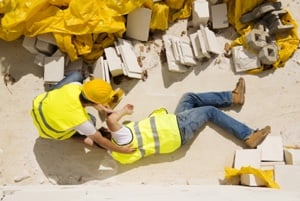 A few weeks ago we began discussing the Occupational Safety and Health Administration’s (OSHA) Fatal Four. These are four safety hazards that account for the majority of all construction worker deaths.
A few weeks ago we began discussing the Occupational Safety and Health Administration’s (OSHA) Fatal Four. These are four safety hazards that account for the majority of all construction worker deaths.
Understanding how to recognize and prevent these hazards can save lives, improve employee morale, and help reduce your contractor insurance costs
Again, the Fatal Four include the following hazards (statistics are from 2016).
- Falls accounted for 38.7% of deaths
- Being struck by an object accounted for 9.4%
- Electrocutions accounted for 8.3%
- Caught-in/between accounted for 7.3%
We covered caught-in/between hazardsand electrical hazardsin previous blogs. Today our focus is on the second highest cause of fatalities (9.4%) among construction workers – struck-by hazards.
What are Struck-By Hazards?
There are a lot of moving parts at a construction site and many hazards that can cause struck-by injuries. When a worker comes into forcible contact with an object that is flying, falling, swinging, or rolling, a struck-by injury can occur.
The four most common causes of struck-by hazards in the construction industry are flying objects, falling objects, swinging objects, and rolling objects.
Prevention:
Your first line of defense against this type of injury is being aware of your surroundings and using hard hats and personal protective equipment (PPE).
Hard hats should be worn on job sites at all times. They should be properly adjusted to sit firmly and securely on the head, and they should be inspected regularly for cracks, gouges, dents, and other damage. Exposure to sunlight and cleaning solvents can damage or weaken a hard hat, so they should be cleaned with mild soap and stored out of direct sunlight.
If a hard hat is damaged or worn out, replace it immediately. It’s much cheaper to replace a hard hat than it is an employee.
Employees should also be equipped with additional PPE where appropriate. PPE that can protect against struck-by injuries may include safety glasses, face shields, and steel-toed boots. All PPE should meet American National Standards Institute standards, and all should be inspected regularly and replaced when damaged or worn out.
Here are preventative measures for each of the most common types of struck-by hazards.
Stuck-by Hazard 1: Flying Objects
Nail gun discharge accidents are the most common cause of flying-object injuries. However, thrown debris or tools, a tip flying off a saw blade, or any other object that is flying around the work site can also cause injuries.
Prevention:
Employees should stay clear of the line of sight when a nail gun is being used. And because nail guns create enough force to penetrate plywood and sheetrock, employees should also be aware if a nail gun is being used in an adjacent room. Check out “Nail gun Safety and Workers Compensation” for more information about nail gun safety.
Additional safety measures include regular inspection of all power tools, the use of protective guards, and wearing safety glasses, face shields, or goggles when working with power tools.
Stuck-by Hazard 2: Falling Objects
This type of injury can be caused by falling tools or materials falling off edges or suspended from a crane.
Prevention:
Areas, where work is being performed overhead, should be cordoned off, so employees avoid those areas. Employees who are working overhead should use toeboards, screens, debris nets, and catch platforms to keep tools and materials from falling
Employees should also be aware of suspended loads and never walk or position themselves under those loads.
Stuck-by Hazard 3: Swinging Objects
Sometimes materials that are being mechanically lifted can begin to sway and can strike a nearby worker.
Prevention:
Employees should be aware when a load is being moved and avoid the swing radius of that load. Workers should also make sure they aren’t in a blind-spot of the heavy equipment operator.
Stuck-by Hazard 4: Rolling Objects
Moving vehicles or heavy equipment usually causes this type of injury, but it can also be caused by objects that roll, move, or slide into an employee.
Prevention:
First, heavy equipment operators should be adequately trained in how to operate the machinery safely. Second, other employees should be aware of where heavy equipment is being operated and understand where the operators have limited or no visibility.
Contact Us and Get Ready to Save on Contractor Insurance!
These preventative measures can significantly reduce worksite injuries and death, which can lead to lower contractors’ insurance premiums. Another way to lower your contractor insurance costs is to contact American Insuring Group at (800) 947-1270 or (610) 775-3848 or connect with us online.
As independent agents, we always compare the cost of your construction insurance among competing insurance companies to make sure that you’re getting the right coverage at the very best price!







